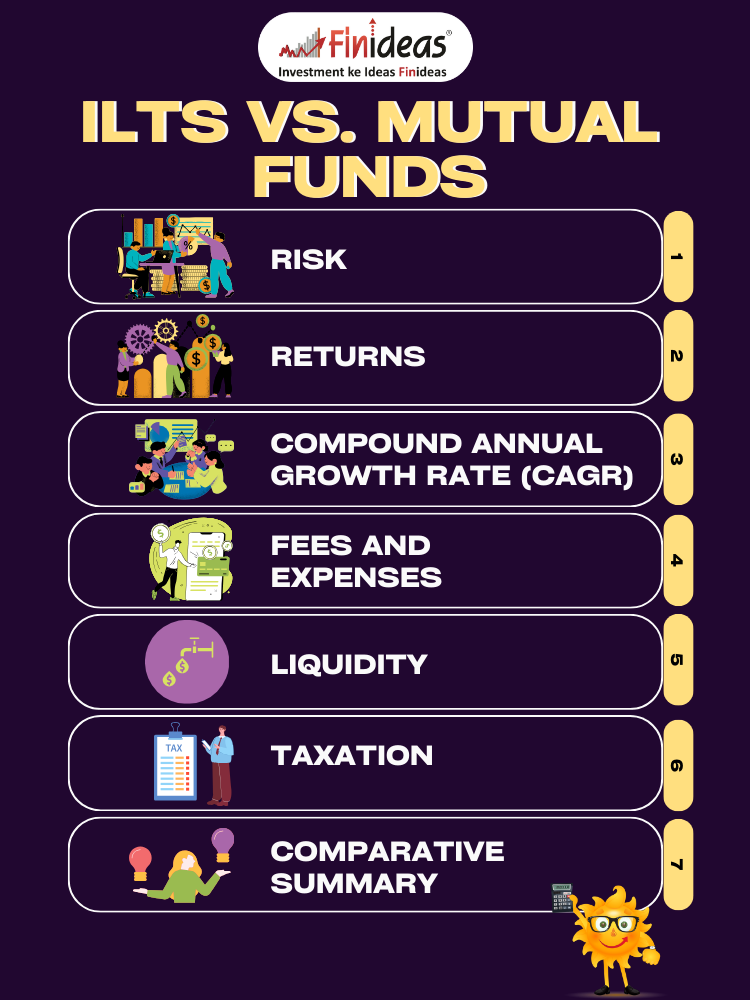ILTS vs. Mutual Funds
When it comes to investing, choosing the right strategy is crucial for achieving your financial goals. Two popular options are the Index Long Term Strategy (ILTS) and Mutual Funds. Each has its own advantages and drawbacks, making them suitable for different types of investors. In this blog, we’ll compare ILTS and Mutual Funds across several key aspects to help you decide which one is the better fit for your investment portfolio.
What are ILTS and Mutual Funds?
Index Long Term Strategy (ILTS):
ILTS involves investing in a diversified portfolio that tracks an entire market index. This strategy aims to replicate the performance of the index while minimizing risk through diversification and hedging techniques.
Mutual Funds:
Mutual Funds pool money from multiple investors to invest in a diversified portfolio of stocks, bonds, or other securities. They are managed by professional fund managers who aim to achieve the fund’s investment objectives.
What is Risk ?
ILTS:
ILTS carries a lower risk due to its diversified nature and hedging through options. The risk level is generally rated at 4%, making it a safer choice compared to individual stock investments.
Mutual Funds:
The risk level of Mutual Funds varies depending on the type of fund (e.g., equity, debt, balanced). Equity Mutual Funds can have higher risk, while debt and balanced funds tend to be less risky. Overall, Mutual Funds provide moderate risk due to their diversified portfolios and professional management.
What are Returns?
ILTS:
ILTS offers the potential for unlimited returns by capturing the overall market movement of the index it tracks. The returns can be substantial over the long term.
Mutual Funds:
Mutual Funds also offer the potential for high returns, particularly equity funds. However, the returns depend on the performance of the underlying assets and the skill of the fund manager. While some funds may outperform the market, others may not.
What is the Compound Annual Growth Rate (CAGR)?
ILTS:
ILTS boasts a historical CAGR of around 18%, reflecting its strong performance in delivering compounded growth over the long term.
Mutual Funds:
The CAGR for Mutual Funds varies widely based on the type of fund and market conditions. Equity Mutual Funds can offer CAGRs comparable to ILTS, while debt funds typically offer lower CAGRs.
What are the Fees and Expenses?
ILTS:
ILTS typically has lower fees compared to Mutual Funds. There are no management fees, and trading costs are minimal due to the passive nature of the strategy.
Mutual Funds:
Mutual Funds charge management fees, which can range from 0.5% to 2% or more of the assets under management. Additionally, there may be other expenses such as administrative fees, which can impact overall returns.
What is Liquidity?
ILTS:
ILTS provides high liquidity as there is no lock-in period. Investors can buy and sell their holdings at any time, offering flexibility and ease of portfolio management.
Mutual Funds:
Most Mutual Funds offer high liquidity, allowing investors to redeem their units on any business day. However, some funds, like ELSS (Equity Linked Savings Scheme), have lock-in periods.
What is Taxation?
ILTS:
Taxation in ILTS primarily involves Long-Term Capital Gains (LTCG) and business income. Gains are subject to tax based on holding periods and prevailing tax regulations.
Mutual Funds:
Taxation for Mutual Funds depends on the type of fund. Equity funds are subject to LTCG tax if held for more than one year, while debt funds have different tax treatments based on the holding period.
Comparative Summary
To provide a clearer comparison, here is a summary table highlighting the key aspects:
Aspect | Index Long Term Strategy (ILTS) | Mutual Funds |
Risk | Low (4%) | Moderate to High |
Returns | Unlimited | High (varies by fund) |
CAGR | 18% | Varies by fund type |
Fees and Expenses | Low | Moderate to High |
Liquidity | High | High |
Taxation | LTCG and business income | Varies by fund type |
Conclusion
Choosing between Index Long Term Strategy (ILTS) and Mutual Funds depends on your individual risk tolerance, investment goals, and preferences for fees and management. ILTS offers a lower-risk, low-cost approach with high liquidity and substantial long-term growth potential. Mutual Funds, managed by professionals, provide a range of options from low to high risk, catering to various investment needs but often come with higher fees.
Before making a decision, evaluate your financial objectives and consider consulting with a financial advisor to determine the best investment strategy for your portfolio.
Happy Investing!
This article is for education purpose only. Kindly consult with your financial advisor before doing any kind of investment..




